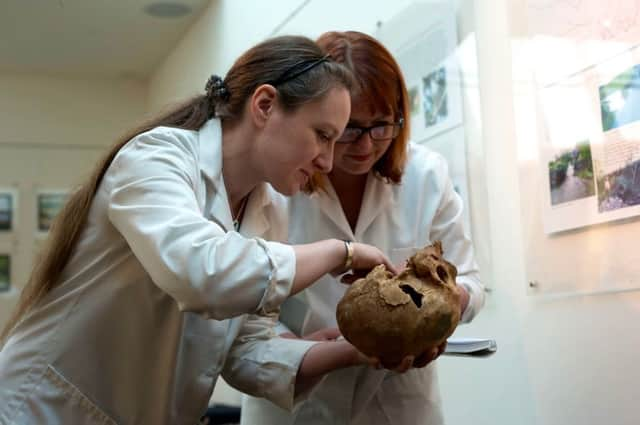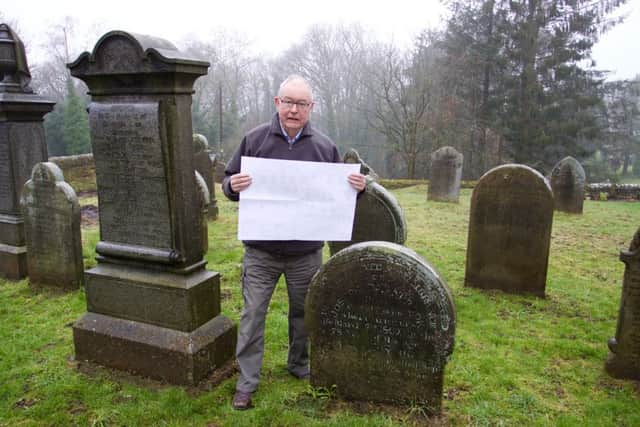Tales from valley of the dead


However, the chain of reservoirs couldn’t drown the area’s rich history, and it was to help keep it alive that churchgoers decided to graft onto the side of the medieval tower a new building they named the Washburn Heritage Centre. Before it could be constructed, there was the small matter of sensitively relocating 14 headstones and the graves beneath them.
But when Northallerton archaeologist John Buglass began excavations he uncovered an astonishing 154 sets of remains. First impressions suggested there could be some fascinating tales to tell, so with the help of £63,000 from the Heritage Lottery Fund it was decided to investigate the story behind this extraordinary burial ground.
Advertisement
Hide AdAdvertisement
Hide AdThe Fewston Assemblage, as the project has become known, is Yorkshire’s very own Meet the Ancestors. And to bring two of the churchyard’s dead as close to life as possible, facial reconstructions were commissioned from the same team that created the likeness of Richard III after his remains were discovered in Leicester. The skeletons were transferred to individual hessian sacks and sent for detailed examination by osteoarchaeologists at York and Durham universities. Meanwhile, through headstones and coffin plates, it had been possible to identify 22 of the 154 buried there, and the centre decided to assign volunteers to each one of the 22 to trace their backgrounds. For a few of the volunteers, it meant seeing the remains of their own ancestors.


Unsurprisingly, many of the dead turned out to reflect the typical life of a village during that period, such as a local tailor, Richard Gill, who was found interred in his wig and socks, and a police constable named Daniel Fox, who died of tuberculosis at the age 33.
But some volunteers turned up unexpected results, none more so than Chris Goodall who was tasked with investigating the life of a farmer’s wife named Mary Darnbrook née Bentley. When he began the process, little did he suspect he would come across the name of Michael Philip Jagger, born on July 27, 1943 in Dartford, Kent, and now better known as Mick Jagger.
Mary Bentley had been born in Gildersome, near Leeds, in 1793 and at the age of 26 she married a farmer, Joseph Darnbrook. When one of her sisters got married it was to someone called David Snell. His sister married a Thomas Jagger, and they became the great-great-great-grandparents of the Rolling Stones frontman. Quite how the Yorkshire Jaggers ended up in Kent was outside the project’s scope, but, says Chris, the genealogy of the Jagger link with Fewston was established for him by members of the Morley Local History Group.
Advertisement
Hide AdAdvertisement
Hide AdOne of his duties as a volunteer researcher was to see the remains from Fewston being examined at Durham University. He found it a dramatic day to finally meet Mary, or at least her skeleton. “It was an emotional moment, perhaps sad and thoughtful,” he says. “Seeing the stark reality of what happens to all humans who opt for burial is quite a jolt.”


The most moving story from the graveyard was researched by Maureen Fackrell, who was given the job of asking questions about the disproportionately large number of adolescents found without headstones. It was suspected they were child labourers who had been brought from London to work in local mills as so-called pauper apprentices. In the Washburn Valley there had been five big textile and flax mills, one of them standing five storeys high.
Children as young as eight were purchased in London for four pounds and two shillings (£255 today), then brought north and effectively enslaved until the age of 21, working from six in the morning until eight at night, six days a week. They were sometimes beaten, and those who ran away risked being sent to the workhouse.
The suspicion about the origin of the adolescents buried at Fewston was confirmed by osteoarchaeologists at York University. Bone analysis showed they were consistent with children who grew up in London. They showed signs of rickets and scurvy, their teeth had severe enamel defects, and some had stunted growth through poor nutrition and disease.
Advertisement
Hide AdAdvertisement
Hide AdJust one baby’s remains were found. Rowland Margerrison had died of whooping cough and exhaustion at the age of ten months. He was buried in a tiny coffin with eight handles and an ornate bronze plate, a sign of how loved he had been. Mikki French, who took on the job of researching his short life, says: “I was strangely drawn to him when we had to collect the skeletons from Durham University for reburial at Fewston. His box was so tiny compared to the rest.”
Within months, Mikki discovered a remarkable coincidence: they were related, and he was her great-great-uncle. Another of the team to meet an ancestor was Mervyn Lister, an auctioneer and surveyor in Otley. He found himself looking at the remains of his great-great-great-grandfather George Lister, who had been a farmer at Timble.
George was one of the two Fewston dead chosen for facial reconstruction. The other was Elizabeth Dibb, whose skull was found to have been subjected to a craniotomy. That is, her head was sawn open, something which often happened in Victorian post-mortems of those who had been mentally ill. Sally Robinson, the Fewston Assemblage team leader, took on the investigation of Elizabeth’s life and found that she had been a patient at High Royds Hospital, Menston, in the days when it was called West Riding Pauper Lunatic Asylum.
Of the unidentified remains, two were particularly curious. One known simply as Skeleton 426 was of a woman aged 26-35 whose tight corset was found to have altered the shape of her ribs. The other was Skeleton 88, a male aged between 35 and 45 who had suffered numerous injuries, perhaps as a soldier or sailor. This seemed likely because of the mother of pearl buttons from a military uniform found with his remains. He had been buried with a George III half crown.
Advertisement
Hide AdAdvertisement
Hide AdApart from the coin and some coffin plates and handles, which are now on display at Washburn Heritage Centre, personal artefacts such as jewellery were returned to the graves when the remains were reburied in an unused part of Fewston churchyard at a special service.
All but one of the original headstones was returned to the churchyard, and the other will be replaced after being broken in transit. A new memorial is also being provided for those whose names were known because of their coffin plates but did not have a gravestone. A third will commemorate the 132 individuals still unidentified.
The new stones are costing £3,000 but are not covered by the Heritage Lottery grant. Says Sally Robinson: “We raise money by running a tearoom and putting on catered events. A piece of cake costs £2 and a cup of tea £1.50, so that’s an awful lot of cups of tea and slices of cake we will have to sell. But it’s worth it.”
There is a small permanent exhibition about the Fewston Assemblage at the Washburn Heritage Centre, and a temporary display of extra information until the end of April. Before then a book and short film about the project will be available. For information visit washburnvalley.org